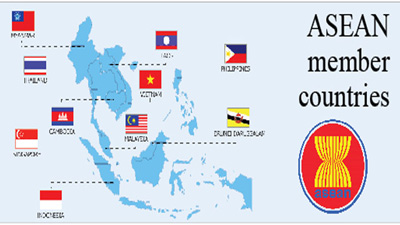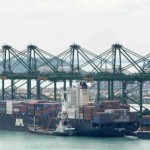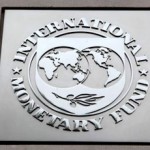Southeast Asia Launches Huge Trade Bloc

Ten countries formalize their integration efforts in a bid to rebalance regional power and riches
Ten Southeast Asian nations start an ambitious, U.S.-backed experiment on Thursday: integrating their economies in a bid to bring more global sway and prosperity to the region’s 622 million citizens.
Their common market—more than a decade in progress—aims to forge a prominent regional bloc to rival China and Japan out of a hodgepodge of economies ranging from rich-and-open Singapore to emerging Myanmar.
Over time, the countries, all members of the Association of Southeast Asian Nations, or Asean, plan to boost economic ties by further lowering tariffs and allowing a freer flow of labor, services and capital across a region stretching 3,900 miles between the Pacific and Indian oceans.
The bloc—which also includes Brunei, Cambodia, Indonesia, Laos, Malaysia, the Philippines, Thailand and Vietnam—is a fast-expanding home to a rising middle class, but also to widespread poverty and income inequality. The group’s leaders hope their effort, which formally begins Thursday but will still take years to complete, will bring economic well-being to more people in a region where they expect a nearly $2.6 trillion combined economy to almost double by 2030.
“It’s a big milestone for us,” said Le Luong Minh, secretary-general of the bloc, called the Asean Economic Community. Less than a half century ago some Southeast Asian countries were still at war, he pointed out. “We’ve made a lot of progress.”
Economic integration within the region is also at the center of the Obama administration’s rebalance of foreign policy toward Asia, in part to address China’s increased military and economic assertiveness in the region. The U.S. has been aiding the effort, for example, by helping Asean countries to integrate their customs and trading procedures.
In the near term, the U.S. isn’t likely to clinch major deals with the Asean community. Instead, American officials hope to launch the Trans-Pacific Partnership, or TPP, a 12-nation trade accord that includes Brunei, Malaysia, Singapore and Vietnam, and expand the bloc to other countries that have expressed interest, including Indonesia and the Philippines. The pact was completed in October but faces a difficult vote in Congress as early as next year.
“The way the United States envisions this is you start with the TPP—you build the ‘gold standard’ for trade—and you slowly build that in Asia to allow better integration,” saidCarl Baker, Hawaii-based director of the Pacific Forum of the Center for Strategic and International Studies. “By working with them as they build the economy community, the United States sees that as an alternative to balance the Chinese economic influence.”
Both the Chinese and Japanese governments also have expressed support for the Asean bloc’s integration efforts, as both jockey for power and influence among their neighbors.
The group’s goals mirror the European Union’s 1950s-era forerunner, another geopolitical bloc whose members suffered decades of strife before uniting. As in Europe, fuller integration could take decades.
The Southeast Asian group doesn’t plan to have a common currency, such as the euro. It still limits cross-border travel, unlike the EU’s passport-free Schengen area. Barriers to cross-border services—financial and transportation, for example—are a work in progress. And although Asean members have cut import tariffs in recent years, other barriers such as import quotas and language requirements for foreign workers will take years to dismantle, experts say.
“The reality, we tell our members, is that you need to have both an Asean strategy and 10 individual strategies as well for now,” saidAlexander Feldman, who heads the U.S.-Asean Business Council.
The bloc’s debut is also stoking some fears.
On a recent December day on the Philippine “sugar bowl” island of Negros, a pall of slick, sweet air cloaked a mill which mashes 5,000 tons of cane a day. In the nearby fields, men worked 10-hour shifts cutting cane in the scorching sun for just $2.40.
Once the Philippine economy’s motor, the industry has been in decline since long before the trade talks began. Now, worries are rising that the bloc will worsen the plight of a sector that still employs 785,000 people, including 440,000 workers on Negros.
Like neighboring Indonesia, the Philippines has slashed its protective 38% import tariff to 5% in recent years to meet Asean’s demands. Both countries are worried about Thailand, which the American Sugar Alliance says subsidizes its industry with $1.3 billion a year, resulting in artificially low prices. Asean doesn’t regulate subsidies. Thailand denies it subsidizes its sugar industry.
“Cheap imports will come in, prices will fall, and our workers and farmers will suffer,” said John Lozande, secretary-general of the National Federation of Sugar Workers. Despite the already lower tariffs, however, he acknowledges this hasn’t happened so far.
Other industries are wary too. Trinh Minh Anh, deputy head of a Vietnamese government panel for international economic integration, said this month that the country’s car-assembling industry will suffer due to competition from Indonesia and Thailand, especially after 2018 when the bloc eliminates auto import tariffs.
In Indonesia, some businesses worry that the bloc’s formation will hasten a brain drain to richer countries such as Singapore and Malaysia. “I’m worried we could lose our best and brightest to better salaries overseas,” said Haryadi Sukamdani, chairman of the Indonesian Employers Association. Those kind of concerns could slow integration, some experts say, as countries struggle to ratify measures agreed upon at a regional level.
The new trade group “will not change our strategy dramatically,” said Eddy Setiawan,who heads Dow Chemical Co.’s Southeast Asian unit. “We have a similar analogy to the EU,” where the company employs individual strategies to reflect the “very different dynamic in each country.”
The bloc has its origins in Asean, a union of mostly developing countries forged in 1967 during the Vietnam War by pro-U.S. governments in the region. The drive for Southeast Asian integration grew during the Asian financial crisis in the late 1990s, when countries whose currencies collapsed felt unfairly treated by global rescue institutions.
Asean hopes to build on that progress not only by boosting trade but in coordinating policies that will benefit its citizens by, for example, lowering cellphone roaming charges and allowing skilled workers to travel freely.
“Any work that gets done to reduce the frictional costs, tariff and trade barriers…is just going to allow us and companies like ours to put more people in and do more,” said John Rice, a General Electric Co. vice chairman who directs the company’s global operations.
Back in Negros, the province is trying to diversify away from sugar by producing bioethanol and electricity from cane, shifting to higher-value crops, solar farms and real estate and welcoming new outsourcing companies, said Alfredo Marañon, the governor of one of the island’s two provinces. Asean integration may help Negros by quickening this diversification push, Mr. Marañon said. Still, that threatens many uneducated sugar workers.
“There will be winners and losers,” said Roehlano Briones, a fellow at the Philippine Institute for Development Studies, a research group. “Consumers and industry will benefit from lower prices, but there is a big pool of very low wage workers who will struggle.”
Source: WSJ – Southeast Asia Launches Huge Trade Bloc





























